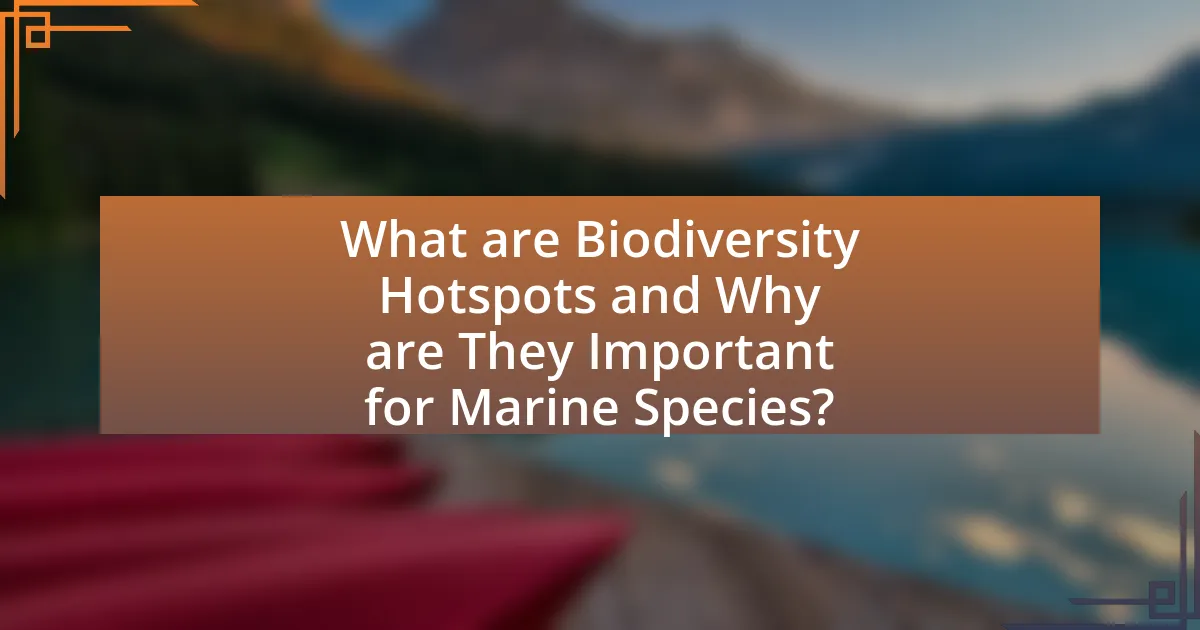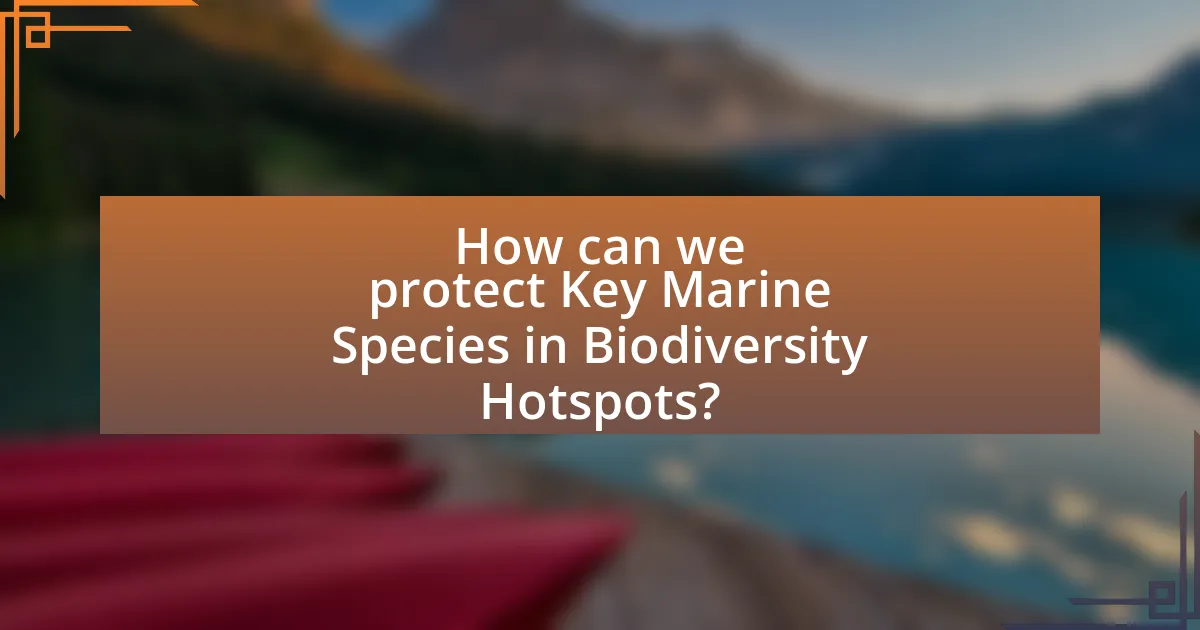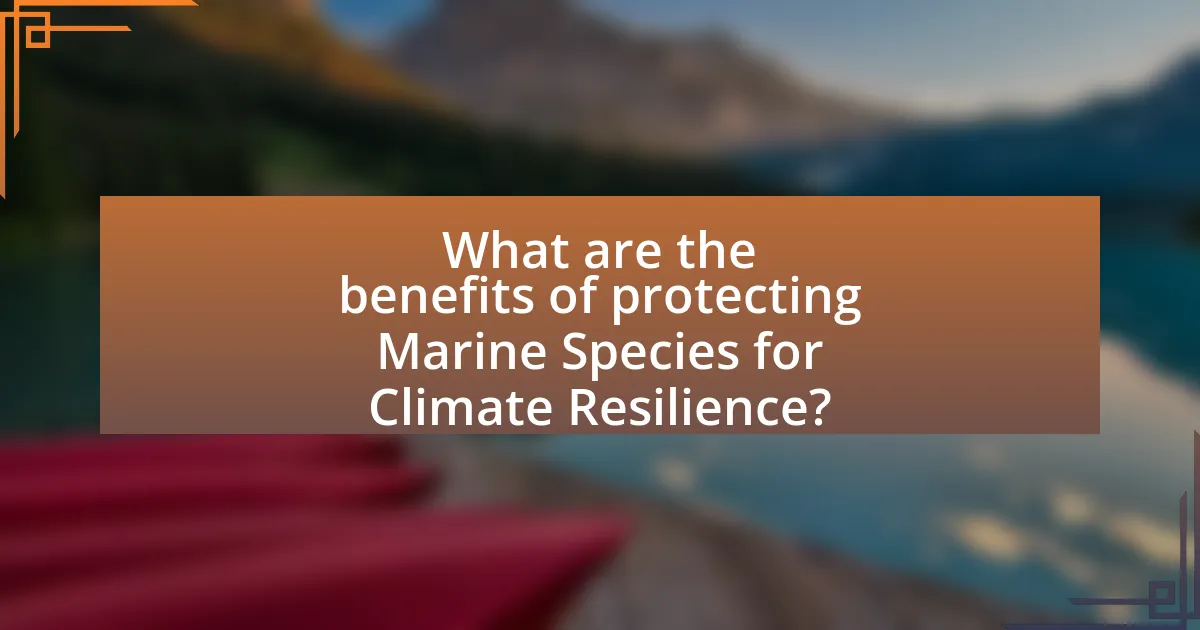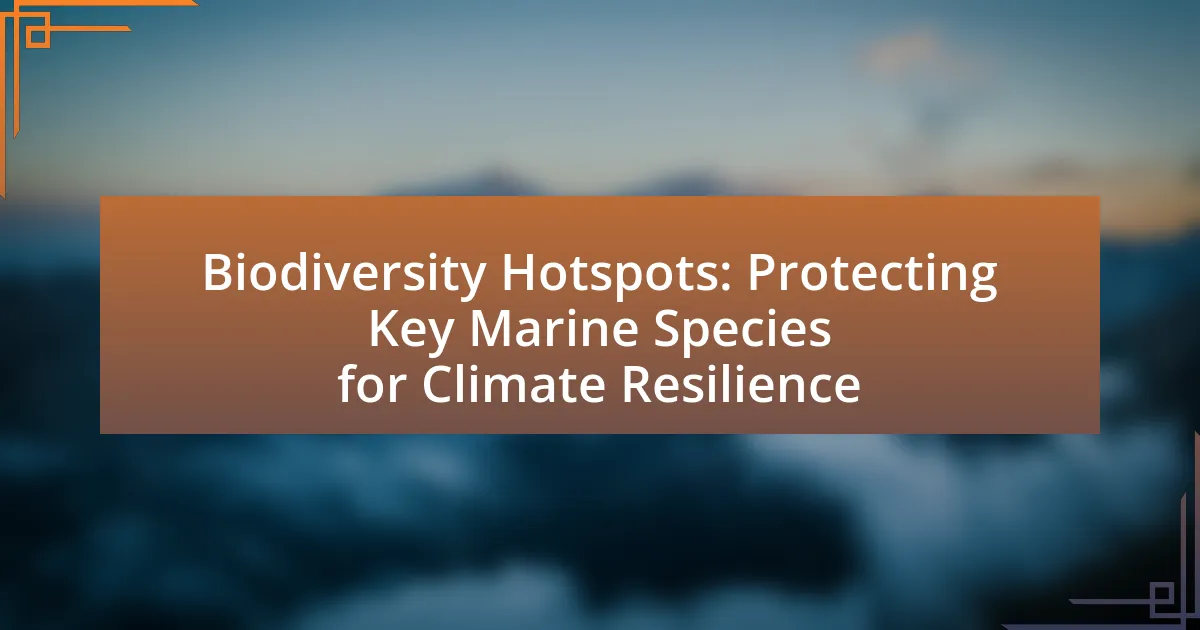Biodiversity hotspots are regions rich in endemic species that face significant threats from human activities, making them crucial for marine species and ecosystem health. This article explores the importance of these hotspots for climate resilience, detailing how they support diverse marine life and provide essential ecosystem services such as carbon sequestration and nutrient cycling. It also examines the specific marine species found in these areas, the threats they face, and the conservation strategies necessary to protect them, including the establishment of marine protected areas and community involvement. Additionally, the article highlights the economic implications of biodiversity loss and practical steps individuals and communities can take to support marine conservation efforts.

What are Biodiversity Hotspots and Why are They Important for Marine Species?
Biodiversity hotspots are regions that are both rich in endemic species and significantly threatened by human activities. These areas are crucial for marine species because they provide essential habitats that support a diverse range of life forms, including many that are unique to these ecosystems. For instance, the Coral Triangle, recognized as a biodiversity hotspot, contains over 600 species of reef-building corals and is vital for the survival of numerous marine organisms. Protecting these hotspots is imperative for maintaining marine biodiversity, as they contribute to ecosystem services such as carbon sequestration, which is vital for climate resilience.
How do Biodiversity Hotspots contribute to climate resilience?
Biodiversity hotspots contribute to climate resilience by preserving diverse ecosystems that enhance adaptive capacity to climate change. These regions, characterized by high levels of endemic species and significant habitat loss, play a crucial role in maintaining ecological functions such as carbon storage, water regulation, and soil stabilization. For instance, tropical forests, often found in biodiversity hotspots, sequester large amounts of carbon dioxide, mitigating climate change impacts. Additionally, diverse ecosystems provide essential services that help communities adapt to changing environmental conditions, such as flood protection and improved agricultural resilience. Studies indicate that areas with rich biodiversity are more resilient to climate stressors, as they can better withstand and recover from disturbances.
What specific marine species are found in these hotspots?
Specific marine species found in biodiversity hotspots include the Hawaiian monk seal, the vaquita porpoise, and various species of coral such as Acropora and Porites. These species are critical to their ecosystems, with the Hawaiian monk seal being an endangered species endemic to the Hawaiian Islands, and the vaquita porpoise being the most endangered marine mammal, with fewer than 30 individuals remaining. Coral species like Acropora are vital for reef building and provide habitat for numerous marine organisms, highlighting their importance in maintaining biodiversity and ecosystem health.
How do these species interact with their ecosystems?
Key marine species interact with their ecosystems primarily through roles such as producers, consumers, and decomposers, which maintain ecological balance. For instance, coral reefs, which are home to diverse marine species, provide habitat and food sources, while species like sea turtles and fish contribute to nutrient cycling and energy flow within these ecosystems. Research indicates that the decline of key species can lead to ecosystem degradation, as seen in studies showing that overfishing disrupts predator-prey relationships, resulting in algal overgrowth and loss of biodiversity. Thus, the interaction of these species is crucial for the health and resilience of marine ecosystems.
What threats do Biodiversity Hotspots face?
Biodiversity Hotspots face significant threats primarily from habitat loss, climate change, invasive species, pollution, and overexploitation. Habitat loss, driven by agriculture, urbanization, and deforestation, reduces the area available for diverse species, leading to population declines. Climate change alters ecosystems, affecting species distribution and survival rates. Invasive species disrupt local ecosystems, often outcompeting native species for resources. Pollution from agricultural runoff and industrial waste contaminates habitats, harming aquatic and terrestrial life. Overexploitation of resources, such as overfishing and unsustainable harvesting, further threatens the delicate balance of these ecosystems. Collectively, these factors contribute to the ongoing decline of biodiversity in these critical areas.
How does climate change impact marine biodiversity?
Climate change significantly impacts marine biodiversity by altering habitats, affecting species distribution, and disrupting ecological interactions. Rising ocean temperatures lead to coral bleaching, which threatens coral reefs that support diverse marine life. Additionally, ocean acidification, caused by increased carbon dioxide absorption, negatively affects shell-forming organisms, disrupting food webs. According to the Intergovernmental Panel on Climate Change (IPCC), marine species are shifting their ranges poleward at an average rate of 72 kilometers per decade due to changing temperatures, which can lead to decreased biodiversity in some regions and increased competition in others. These changes ultimately threaten the resilience of marine ecosystems, making it crucial to protect key species and habitats.
What human activities threaten these ecosystems?
Human activities that threaten marine ecosystems include overfishing, pollution, habitat destruction, and climate change. Overfishing depletes fish populations and disrupts food webs, leading to ecosystem imbalances. Pollution from agricultural runoff, plastics, and industrial waste contaminates water and harms marine life, as evidenced by the Great Pacific Garbage Patch, which contains millions of tons of plastic debris. Habitat destruction occurs through coastal development and destructive fishing practices, such as bottom trawling, which devastates seabed habitats. Climate change, driven by greenhouse gas emissions, leads to ocean acidification and rising temperatures, adversely affecting coral reefs and marine biodiversity. These activities collectively jeopardize the health and resilience of marine ecosystems.

How can we protect Key Marine Species in Biodiversity Hotspots?
To protect key marine species in biodiversity hotspots, implementing marine protected areas (MPAs) is essential. MPAs restrict human activities such as fishing and coastal development, allowing ecosystems to recover and thrive. Research indicates that well-managed MPAs can lead to increased biodiversity and fish populations, with studies showing that fish biomass can increase by up to 600% within protected zones. Additionally, enforcing sustainable fishing practices and reducing pollution through stricter regulations can further safeguard these species. The International Union for Conservation of Nature (IUCN) emphasizes that effective management of MPAs, combined with community engagement, is crucial for the long-term protection of marine biodiversity.
What conservation strategies are most effective?
Effective conservation strategies include the establishment of marine protected areas (MPAs), habitat restoration, and sustainable fisheries management. Marine protected areas have been shown to enhance biodiversity and resilience against climate change by providing safe havens for marine species, as evidenced by a study published in “Nature” which found that MPAs can increase fish populations by up to 600% over time. Habitat restoration, such as coral reef rehabilitation, has been proven to improve ecosystem health and biodiversity, with research indicating that restored reefs can support similar levels of biodiversity as natural reefs. Sustainable fisheries management practices, including catch limits and gear restrictions, have been demonstrated to prevent overfishing and ensure the long-term viability of fish stocks, contributing to healthier marine ecosystems.
How do marine protected areas contribute to species protection?
Marine protected areas (MPAs) contribute to species protection by providing safe habitats where marine life can thrive without the pressures of human activities such as fishing and pollution. These designated zones help to preserve biodiversity by allowing ecosystems to recover and maintain their natural functions. Research indicates that MPAs can lead to increased fish populations and greater species diversity; for example, a study published in the journal “Nature” found that fully protected MPAs can increase fish biomass by an average of 446% compared to unprotected areas. This significant enhancement in marine life supports not only the species within the MPAs but also the surrounding ecosystems, contributing to overall marine health and resilience against climate change.
What role do local communities play in conservation efforts?
Local communities play a crucial role in conservation efforts by actively participating in the management and protection of biodiversity hotspots. Their involvement often leads to more effective conservation outcomes, as local knowledge and practices are integrated into conservation strategies. For instance, studies have shown that community-led initiatives can enhance marine biodiversity by implementing sustainable fishing practices, which directly contribute to the resilience of key marine species against climate change. Additionally, local communities often serve as stewards of their environments, advocating for policies that protect their natural resources and ensuring that conservation efforts align with their cultural and economic needs.
What policies support the protection of marine biodiversity?
Policies that support the protection of marine biodiversity include the Marine Protected Areas (MPAs), the Convention on Biological Diversity (CBD), and the United Nations Sustainable Development Goals (SDGs). MPAs restrict human activities in designated areas to conserve marine ecosystems and species, with over 7% of the world’s oceans currently designated as MPAs, according to the World Database on Protected Areas. The CBD, adopted in 1992, aims to promote sustainable development through the conservation of biological diversity, with specific targets for marine environments. Additionally, the SDGs, particularly Goal 14, emphasize the need to conserve and sustainably use the oceans, seas, and marine resources, highlighting the importance of marine biodiversity for climate resilience and ecosystem health.
How do international agreements influence local conservation efforts?
International agreements significantly influence local conservation efforts by establishing frameworks that promote biodiversity protection and sustainable practices. These agreements, such as the Convention on Biological Diversity, set binding targets and guidelines that local governments must follow, thereby aligning national policies with global conservation goals. For instance, the Aichi Biodiversity Targets, adopted in 2010, aim to protect ecosystems and species, which local authorities implement through specific conservation strategies and regulations. This alignment often leads to increased funding and resources for local initiatives, as countries seek to fulfill their international commitments, thereby enhancing the effectiveness of local conservation efforts.
What funding mechanisms are available for biodiversity protection?
Funding mechanisms available for biodiversity protection include government grants, international funding organizations, private sector investments, and non-profit contributions. Government grants often come from environmental agencies that allocate budget for conservation projects, while international organizations like the Global Environment Facility provide financial support for biodiversity initiatives globally. Private sector investments can be sourced through corporate social responsibility programs that focus on sustainability. Non-profit organizations also play a crucial role by raising funds through donations and partnerships aimed at specific biodiversity projects. These mechanisms collectively contribute to the preservation of biodiversity, particularly in critical areas like marine ecosystems, which are essential for climate resilience.

What are the benefits of protecting Marine Species for Climate Resilience?
Protecting marine species enhances climate resilience by maintaining ecosystem balance and promoting biodiversity. Healthy marine ecosystems, such as coral reefs and mangroves, act as natural barriers against storm surges and coastal erosion, reducing the impact of climate change on coastal communities. For instance, mangroves can reduce wave energy by up to 66%, significantly mitigating flooding risks. Additionally, diverse marine species contribute to nutrient cycling and carbon sequestration, which are crucial for regulating climate. Research indicates that preserving marine biodiversity can increase ecosystem productivity and stability, making these systems more resilient to climate fluctuations.
How does marine biodiversity enhance ecosystem services?
Marine biodiversity enhances ecosystem services by maintaining the balance and functionality of marine ecosystems, which are crucial for human well-being. Diverse marine species contribute to nutrient cycling, habitat structure, and resilience against environmental changes. For instance, coral reefs, which host a multitude of species, provide essential services such as coastal protection, tourism, and fisheries support. Research indicates that ecosystems with higher biodiversity are more productive and stable, as they can better withstand disturbances and recover from stressors, such as climate change. A study published in “Nature” by Cardinale et al. (2012) found that biodiversity loss can significantly reduce ecosystem productivity and stability, highlighting the importance of preserving marine biodiversity for sustaining vital ecosystem services.
What specific services do healthy marine ecosystems provide?
Healthy marine ecosystems provide essential services such as carbon sequestration, habitat provision, and nutrient cycling. These ecosystems, including coral reefs, mangroves, and seagrasses, play a critical role in absorbing carbon dioxide from the atmosphere, thus mitigating climate change. For instance, mangroves can sequester up to four times more carbon per hectare than tropical forests. Additionally, they serve as habitats for diverse marine species, supporting biodiversity and fisheries that are vital for food security. Nutrient cycling in these ecosystems helps maintain water quality and supports primary production, which is fundamental for the entire marine food web.
How can biodiversity contribute to food security?
Biodiversity contributes to food security by enhancing ecosystem resilience, which ensures stable food production. Diverse ecosystems provide a variety of species that can adapt to changing environmental conditions, thereby maintaining agricultural productivity. For instance, studies show that diverse crop systems can yield up to 20% more than monocultures, as they are better equipped to withstand pests and diseases. Additionally, biodiversity supports pollination and nutrient cycling, which are critical for crop health and yield. The Food and Agriculture Organization highlights that maintaining genetic diversity in crops and livestock is essential for adapting to climate change and ensuring food availability.
What are the long-term impacts of biodiversity loss on climate resilience?
Biodiversity loss significantly undermines climate resilience by reducing ecosystems’ ability to adapt to changing environmental conditions. Healthy ecosystems, rich in biodiversity, provide essential services such as carbon sequestration, water filtration, and soil stabilization, which are crucial for mitigating climate impacts. For instance, diverse marine ecosystems like coral reefs and mangroves can absorb higher levels of carbon dioxide and protect coastal areas from storm surges, thereby enhancing resilience against climate change. Studies indicate that ecosystems with higher biodiversity are more productive and better able to withstand disturbances, as evidenced by research published in “Nature” by Cardinale et al. (2012), which found that biodiversity loss can lead to decreased ecosystem functioning and increased vulnerability to climate-related stressors.
How does the decline of key species affect ecosystem stability?
The decline of key species significantly destabilizes ecosystems by disrupting food webs and nutrient cycling. For instance, the loss of apex predators, such as sharks, can lead to overpopulation of prey species, which in turn depletes vegetation and alters habitat structures. This phenomenon has been documented in various marine environments, where the removal of a single species has cascading effects on biodiversity and ecosystem health. Research indicates that ecosystems with higher biodiversity are more resilient to disturbances, highlighting the critical role that key species play in maintaining ecological balance.
What are the potential economic consequences of losing marine biodiversity?
The potential economic consequences of losing marine biodiversity include significant declines in fisheries, tourism, and coastal protection services. Fisheries rely on diverse marine species for sustainable catches; a loss in biodiversity can lead to overfishing and collapse of fish stocks, which in 2018 was estimated to cost the global economy up to $83 billion annually. Additionally, marine biodiversity supports tourism, with coral reefs alone generating approximately $36 billion per year in tourism revenue. Furthermore, healthy marine ecosystems provide natural coastal protection, reducing the costs associated with storm damage and erosion, which can reach billions of dollars in vulnerable regions. Thus, the economic ramifications of losing marine biodiversity are profound and multifaceted, impacting food security, livelihoods, and coastal resilience.
What practical steps can individuals take to support marine biodiversity?
Individuals can support marine biodiversity by reducing plastic use, participating in beach clean-ups, and advocating for sustainable seafood choices. Reducing plastic use minimizes ocean pollution, which is a significant threat to marine life; studies show that over 8 million tons of plastic enter the oceans annually, harming wildlife and ecosystems. Beach clean-ups directly remove debris that can entangle or be ingested by marine animals, contributing to healthier habitats. Advocating for sustainable seafood helps protect overfished species and promotes responsible fishing practices, as approximately 34% of global fish stocks are overfished, according to the Food and Agriculture Organization. These actions collectively contribute to the preservation of marine biodiversity and the resilience of ocean ecosystems.
How can sustainable seafood choices make a difference?
Sustainable seafood choices can significantly reduce overfishing and protect marine ecosystems. By opting for seafood sourced from well-managed fisheries or aquaculture, consumers help maintain fish populations and promote biodiversity. For instance, the Marine Stewardship Council reports that sustainable fishing practices can lead to healthier ocean environments, which are crucial for climate resilience. Additionally, choosing sustainable seafood can support local economies and encourage responsible fishing practices, further contributing to the conservation of key marine species.
What actions can communities take to promote marine conservation?
Communities can promote marine conservation by implementing local policies that protect marine habitats and establish marine protected areas (MPAs). These actions help preserve biodiversity and enhance ecosystem resilience against climate change. For instance, the establishment of MPAs has been shown to increase fish populations and improve the health of marine ecosystems, as evidenced by a study published in the journal “Nature” which found that MPAs can lead to a 446% increase in fish biomass over time. Additionally, communities can engage in educational programs to raise awareness about the importance of marine conservation, which has been proven to foster community involvement and support for sustainable practices.
